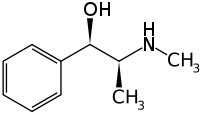|
Ephedrine
CAS number 299-42-3
 These
terms are used to refer to the same substance derived from the plant
Ephedra is a shrub-like plant that is found in desert regions in central
Asia and other parts of the world. The dried greens of the plant are
used medicinally. Ephedra is a stimulant containing the herbal form of
ephedrine, an FDA-regulated drug found in over-the-counter asthma
medications.Ephedrine alkaloids are amphetamine-like compounds used in
OTC and prescription drugs with potentially lethal stimulant effects on
the central nervous system and heart. The FDA has received more than 800
reports of adverse effects associated with use of products containing
ephedrine alkaloid since 1994. These serious adverse effects, include
hypertension (elevated blood pressure), palpitations (rapid heart rate),
neurophathy (nerve damage), myopathy (muscle injury), psychosis, stroke,
memory loss, heart rate irregularities, insomnia, nervousness, tremors,
seizures, heart attacks, and death. The agency has proposed to prohibit
the marketing of dietary supplements containing 8 milligrams or more of
ephedrine alkaloids per serving. These
terms are used to refer to the same substance derived from the plant
Ephedra is a shrub-like plant that is found in desert regions in central
Asia and other parts of the world. The dried greens of the plant are
used medicinally. Ephedra is a stimulant containing the herbal form of
ephedrine, an FDA-regulated drug found in over-the-counter asthma
medications.Ephedrine alkaloids are amphetamine-like compounds used in
OTC and prescription drugs with potentially lethal stimulant effects on
the central nervous system and heart. The FDA has received more than 800
reports of adverse effects associated with use of products containing
ephedrine alkaloid since 1994. These serious adverse effects, include
hypertension (elevated blood pressure), palpitations (rapid heart rate),
neurophathy (nerve damage), myopathy (muscle injury), psychosis, stroke,
memory loss, heart rate irregularities, insomnia, nervousness, tremors,
seizures, heart attacks, and death. The agency has proposed to prohibit
the marketing of dietary supplements containing 8 milligrams or more of
ephedrine alkaloids per serving.
Systematic (IUPAC) name
(1R,2S)-2-(methylamino)-1-phenylpropan-1-ol
Identifiers
CAS number 299-42-3
ATC code R01AA03 R03CA02 S01FB02
PubChem 5032
DrugBank DB01364
ChemSpider 8935
Chemical data
Formula C10H15NO
Mol. mass 165.23
SMILES eMolecules & PubChem
Pharmacokinetic data
Bioavailability 85%
Metabolism minimal hepatic
Half life 3–6 hours
Excretion 22-99% renal
Therapeutic considerations
Routes oral, IV, IM, SC
 This
drug should not be used in combination with other stimulant products
(e.g., caffeine), other cough-and-cold products, or as a dietary
supplement for the purpose of weight loss or body building. Doing so may
increase your risk of unlikely but potentially fatal side effects
including: stroke, heart attack, seizures, or severe mental disorders. This
drug should not be used in combination with other stimulant products
(e.g., caffeine), other cough-and-cold products, or as a dietary
supplement for the purpose of weight loss or body building. Doing so may
increase your risk of unlikely but potentially fatal side effects
including: stroke, heart attack, seizures, or severe mental disorders.
In addition, dietary supplements containing ephedrine should not exceed
8 mg as a single ephedrine dose, 24 mg of ephedrine per day (24 hours),
or be given for longer than 7 days, as recommended by the FDA. Exceeding
the recommended ephedrine dose increases your risk of the side effects
noted above. For detailed information, consult your pharmacist. Check
all product labels carefully to see if they contain ephedrine.
USES: Ephedrine is a central nervous system stimulant used to
treat breathing problems (as a bronchodilator), nasal congestion (as a
decongestant), low blood pressure problems (orthostatic hypotension), or
myasthenia gravis.
OTHER USES: This drug has also been used to treat certain sleep
disorders (narcolepsy), menstrual problems (dysmenorrhea), or
urine-control problems (incontinence or enuresis).
| |
|
Note
/Government Notification: These chemicals are designated as
those that are used in the manufacture of the controlled substances
and are important to the manufacture of the substances. For any
(Control Substance) products Import and Export *** subjected to your
country government laws /control substance ACT.
Information: The information on this web page
is provided to help you to work safely, but it is intended to be an
overview of hazards, not a replacement for a full Material Safety
Data Sheet (MSDS). MSDS forms can be downloaded from the web sites
of many chemical suppliers. ,also that the information on the PTCL
Safety web site, where this page was hosted, has been copied onto
many other sites, often without permission. If you have any doubts
about the veracity of the information that you are viewing, or have
any queries, please check the URL that your web browser displays for
this page. If the URL begins "www.tajapi.com/www/Denatonium
Benzoate.htm/" the page is maintained by the Safety Officer in
Physical Chemistry at Oxford University. If not, this page is a copy
made by some other person and we have no responsibility for it.
The Controlled Substances Act (CSA) was enacted into law by the
Congress of the United States as Title II of the Comprehensive Drug
Abuse Prevention and Control Act of 1970.[1] The CSA is the federal
U.S. drug policy under which the manufacture, importation,
possession, use and distribution of certain substances is regulated.
The Act also served as the national implementing legislation for the
Single Convention on Narcotic Drugs |
|
|
|
|



 These
terms are used to refer to the same substance derived from the plant
Ephedra is a shrub-like plant that is found in desert regions in central
Asia and other parts of the world. The dried greens of the plant are
used medicinally. Ephedra is a stimulant containing the herbal form of
ephedrine, an FDA-regulated drug found in over-the-counter asthma
medications.Ephedrine alkaloids are amphetamine-like compounds used in
OTC and prescription drugs with potentially lethal stimulant effects on
the central nervous system and heart. The FDA has received more than 800
reports of adverse effects associated with use of products containing
ephedrine alkaloid since 1994. These serious adverse effects, include
hypertension (elevated blood pressure), palpitations (rapid heart rate),
neurophathy (nerve damage), myopathy (muscle injury), psychosis, stroke,
memory loss, heart rate irregularities, insomnia, nervousness, tremors,
seizures, heart attacks, and death. The agency has proposed to prohibit
the marketing of dietary supplements containing 8 milligrams or more of
ephedrine alkaloids per serving.
These
terms are used to refer to the same substance derived from the plant
Ephedra is a shrub-like plant that is found in desert regions in central
Asia and other parts of the world. The dried greens of the plant are
used medicinally. Ephedra is a stimulant containing the herbal form of
ephedrine, an FDA-regulated drug found in over-the-counter asthma
medications.Ephedrine alkaloids are amphetamine-like compounds used in
OTC and prescription drugs with potentially lethal stimulant effects on
the central nervous system and heart. The FDA has received more than 800
reports of adverse effects associated with use of products containing
ephedrine alkaloid since 1994. These serious adverse effects, include
hypertension (elevated blood pressure), palpitations (rapid heart rate),
neurophathy (nerve damage), myopathy (muscle injury), psychosis, stroke,
memory loss, heart rate irregularities, insomnia, nervousness, tremors,
seizures, heart attacks, and death. The agency has proposed to prohibit
the marketing of dietary supplements containing 8 milligrams or more of
ephedrine alkaloids per serving. This
drug should not be used in combination with other stimulant products
(e.g., caffeine), other cough-and-cold products, or as a dietary
supplement for the purpose of weight loss or body building. Doing so may
increase your risk of unlikely but potentially fatal side effects
including: stroke, heart attack, seizures, or severe mental disorders.
This
drug should not be used in combination with other stimulant products
(e.g., caffeine), other cough-and-cold products, or as a dietary
supplement for the purpose of weight loss or body building. Doing so may
increase your risk of unlikely but potentially fatal side effects
including: stroke, heart attack, seizures, or severe mental disorders.


